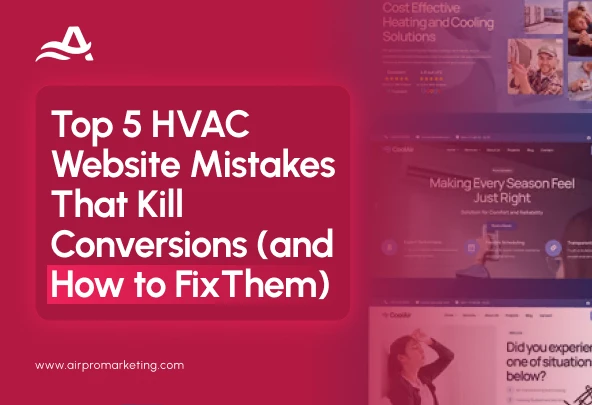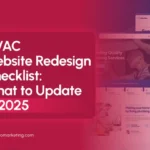Your HVAC website might look good, but is it actually turning visitors into customers? For heating and cooling companies, the difference between a website that generates leads and one that doesn’t often come down to seemingly small details that have big impacts. Research shows that 53% of shoppers report that they always do research before they complete a purchase, making your online presence crucial in capturing these information-seeking customers.
Effective digital marketing for HVAC involves creating a website that actively converts visitors into callers and customers. Many HVAC business owners invest thousands in building websites only to wonder why they aren’t seeing returns on that investment. The truth is that common design and content mistakes can sabotage even the most professional-looking sites. By identifying and fixing these conversion killers, you can transform your website from a digital business card into a lead-generating powerhouse.
5 HVAC Website Mistakes That Kill Conversions
The following are the top five website errors HVAC companies often make that hinder their ability to attract and convert online visitors into paying customers.
1. Hiding Contact Information
Perhaps the most common yet devastating mistake on HVAC websites is making contact information difficult to find. When potential customers need heating or cooling services, they often need them urgently. If your phone number isn’t immediately visible, many visitors will simply hit the back button and call your competitor.
The Problem:
- Contact information buried in “Contact Us” pages that require extra clicks
- Phone numbers displayed as images that can’t be tapped to call on mobile devices
- Lack of call-to-action buttons that stand out visually
- Contact forms that ask for too much information up front
- No clear indication of service areas or hours of operation
A surprising number of HVAC websites require visitors to scroll all the way to the bottom to find a phone number or click through multiple pages. By then, many potential customers have already given up.
The Solution:
Make contacting you ridiculously easy by ensuring your phone number appears prominently in the top right corner of every page. For mobile users, this number should be tap-to-call enabled. Include a brightly colored button with action text like “Schedule Service Now” or “Get Emergency Repair” in multiple locations throughout your site.
For best results, place your main service areas and hours next to your contact information. If you offer 24/7 emergency service, make sure that’s clearly stated near your phone number since it’s a major selling point in the HVAC industry. These simple changes can dramatically increase your conversion rate without requiring a complete website redesign.
2. Overwhelming Visitors with Technical Jargon
HVAC professionals understand terms like “SEER ratings,” “load calculations,” and “refrigerant types,” but most homeowners don’t. When your website overuses technical terminology without explanation, it creates a disconnect with potential customers who just want simple solutions to their comfort problems.
The Problem:
- Content written for industry peers rather than homeowners
- Excessive focus on equipment specifications rather than benefits
- The assumption that customers understand HVAC terminology
- Lack of simple explanations for complex concepts
- Missing the emotional aspects of home comfort
Many HVAC companies fall into the trap of showcasing their technical expertise through jargon, but this approach often backfires by making customers feel intimidated or confused.
The Solution:
Rewrite your content from the customer’s perspective, focusing on benefits rather than specifications. Instead of “We install high-efficiency 20 SEER systems,” try “Our energy-efficient systems can cut your cooling bills by up to 40%.”
Use simple language that emphasizes comfort, savings, and peace of mind. When technical terms are necessary, briefly explain them in parentheses or through simple analogies. Remember that effective digital marketing for HVAC means speaking your customers’ language, not expecting them to learn yours.
This customer-centered approach is increasingly important as the HVAC industry continues to expand. The global HVAC systems market size was estimated at USD 249.37 billion in 2024 and is projected to grow at a CAGR of 7.5% from 2025 to 2030. With this significant growth comes greater competition, making clear communication with potential customers a critical differentiator.
3. Neglecting Social Proof and Credibility Indicators
In an industry where trust is paramount, many HVAC websites fail to provide evidence that they’re reliable and respected. Homeowners are understandably cautious about who they allow into their homes, especially for services that can be costly.
The Problem:
- Missing or hard-to-find customer testimonials
- No mention of licenses, certifications, or insurance
- Absence of third-party verification (BBB, Google reviews, etc.)
- Generic stock photos instead of real team members or work examples
- No mention of experience or years in business
Without clear trust signals, potential customers have no way to distinguish your company from less reputable competitors, increasing their hesitation to contact you.
The Solution:
Feature authentic customer testimonials prominently throughout your site, especially on key landing pages. Include the customer’s full name and location when possible to increase credibility. Showcase your company’s ratings on Google, Yelp, or industry-specific review sites, and link directly to your profiles.
Display all relevant certifications, licensure information, and manufacturer partnerships prominently. If you’re a certified dealer for major brands like Carrier, Trane, or Lennox, make sure those logos are visible. Include actual photos of your team, trucks, and completed installations when possible.
For maximum impact, create a dedicated “Why Choose Us” section that summarizes your experience, guarantees, satisfaction rate, and other differentiators in a skimmable format. These trust signals reduce perceived risk and significantly increase conversion rates.
4. Poor Mobile Experience
63% of website traffic comes from people using mobile devices, yet many companies’ websites remain difficult to use on smartphones. This creates immediate frustration for potential customers who need service quickly.
The Problem:
- Text too small to read without zooming
- Buttons and links too close together, causing “fat finger” errors
- Contact forms that are cumbersome to complete on mobile
- Slow loading times on cellular connections
- Images that don’t resize properly for smaller screens
A poor mobile experience creates the impression that your company isn’t modern or customer-focused, sending visitors straight to competitors with more accessible websites.
The Solution:
Invest in responsive design that automatically adjusts your website layout for different screen sizes. Ensure all buttons are large enough to tap easily with a finger (at least 44×44 pixels) and leave adequate space between clickable elements.
Simplify your contact forms for mobile users by requesting only essential information upfront. Implement click-to-call buttons prominently at the top of the mobile experience and again throughout the page, eliminating friction for smartphone users.
Test your website’s mobile loading speed using Google’s PageSpeed Insights and address any issues that are slowing it down. Images should be properly optimized for web use, and unnecessary scripts should be eliminated. These mobile optimizations are crucial components of successful digital marketing for HVAC companies in the smartphone-dominated marketplace.
5. Unclear Service Offerings and Pricing Transparency
Many HVAC websites leave potential customers guessing about what services they offer, which brands they carry, or how their pricing works. This uncertainty creates hesitation at the critical moment when visitors are deciding whether to contact you.
The Problem:
- Vague descriptions of services without specific details
- No mention of brands or equipment options
- Lack of any pricing information or cost ranges
- Missing information about financing, rebates, or special offers
- No clear explanation of the service process
When customers can’t find basic information about what you offer and how you work, they often assume the worst or simply move on to a competitor whose website answers their questions.
The Solution:
Create dedicated pages for each major service category (installation, repair, maintenance) with clear descriptions of what’s included. List the specific brands and equipment types you work with, highlighting any special certifications or dealer relationships.
While exact pricing may vary by job, provide general price ranges or starting points when possible (“Maintenance plans starting at $X per month” or “Most repairs range from $X to $Y”). Clearly describe any diagnostic fees or service call charges upfront.
Prominently feature information about financing options, current promotions, and available rebates. Create a “What to Expect” section that walks customers through your service process from first call to completion, reducing uncertainty and building confidence in your company.
Bottom Line
Fixing these five common website mistakes can improve your conversion rate without requiring a complete redesign. Don’t forget that your website is the first impression potential customers have of your business. When designed with conversion in mind, it becomes your most cost-effective salesperson, working 24/7 to turn visitors into customers.
Tired of watching potential customers visit your website only to disappear without calling? Air Pro Marketing specializes in turning underperforming HVAC websites into lead-generating powerhouses. We know exactly what makes homeowners pick up the phone and call for service.
Stop losing customers to competitors with better websites. Get in touch with our experts for a free consultation that reveals exactly where your site is leaking leads and how quickly we can fix it!
FAQs
How much does it cost to fix conversion issues on an HVAC website?
The cost varies depending on the extent of the problems, but many conversion issues can be fixed for between $1,500-$3,000, an investment that pays for itself within 2-3 months through increased leads. Some changes, like making your phone number more prominent or simplifying contact forms, can even be implemented without professional help using most website builders’ basic editing tools.
How can I tell if my website has conversion problems?
Look at your website analytics to find your bounce rate (the percentage of visitors who leave without taking action) and average time on site. If your bounce rate is above 70% or average time on site is under 1 minute, you likely have conversion issues. Another clear indicator is if you’re getting traffic but few phone calls or form submissions from your website visitors.
Do I need to completely rebuild my website to improve conversions?
In most cases, no. Many of the highest-impact conversion improvements involve relatively simple changes to your existing site, such as reorganizing information, improving calls-to-action, adding testimonials, and enhancing mobile functionality. A complete rebuild is only necessary if your site has fundamental technical or structural problems.
How important is local SEO for HVAC websites compared to conversion optimization?
Both are essential parts of a successful digital strategy. Even the best SEO bringing thousands of visitors is wasted if your website doesn’t convert those visitors into leads. Ideally, focus on conversion optimization first, then invest in local SEO to bring more qualified traffic to your newly optimized site. The combination of high visibility and strong conversion rates creates the most profitable outcome for HVAC businesses.
Author Profile
Latest entries
 Digital MarketingJuly 8, 2025What to Look for in a Web Development Company for Your HVAC Business?
Digital MarketingJuly 8, 2025What to Look for in a Web Development Company for Your HVAC Business? Digital MarketingJune 23, 2025How Our HVAC Web Development Services Can Improve Your Local SEO?
Digital MarketingJune 23, 2025How Our HVAC Web Development Services Can Improve Your Local SEO? Digital MarketingJune 18, 2025HVAC Website Redesign Checklist: What to Update in 2025
Digital MarketingJune 18, 2025HVAC Website Redesign Checklist: What to Update in 2025 Digital MarketingJune 16, 2025Top 5 HVAC Website Mistakes That Kill Conversions (and How to Fix Them)
Digital MarketingJune 16, 2025Top 5 HVAC Website Mistakes That Kill Conversions (and How to Fix Them)




